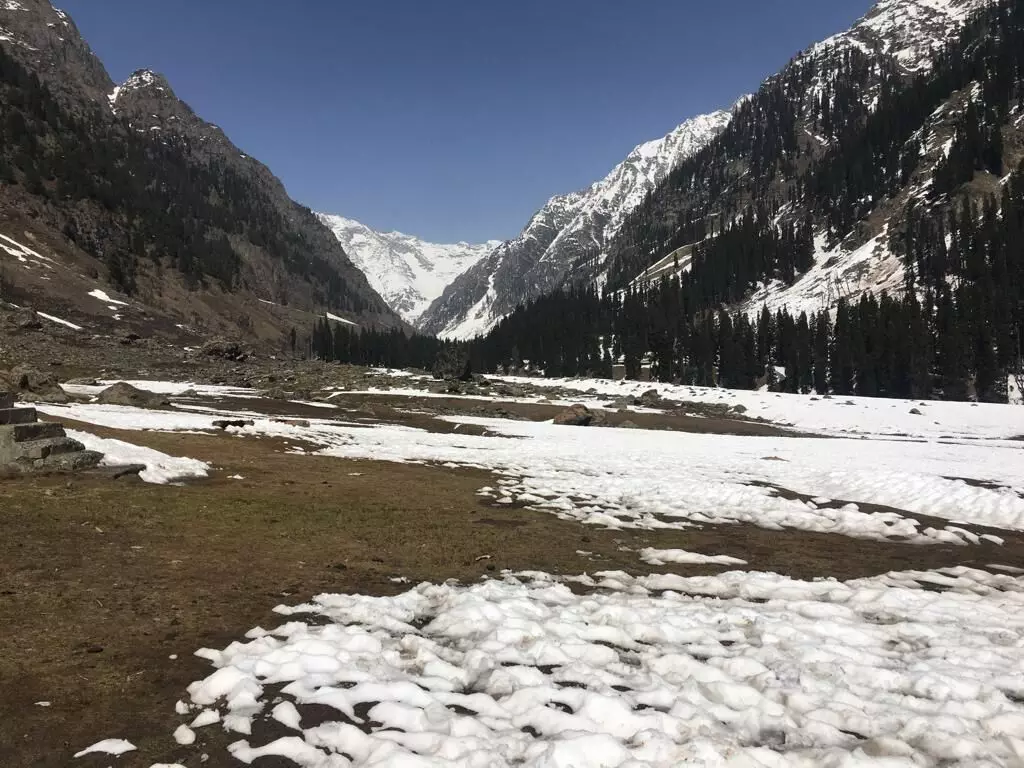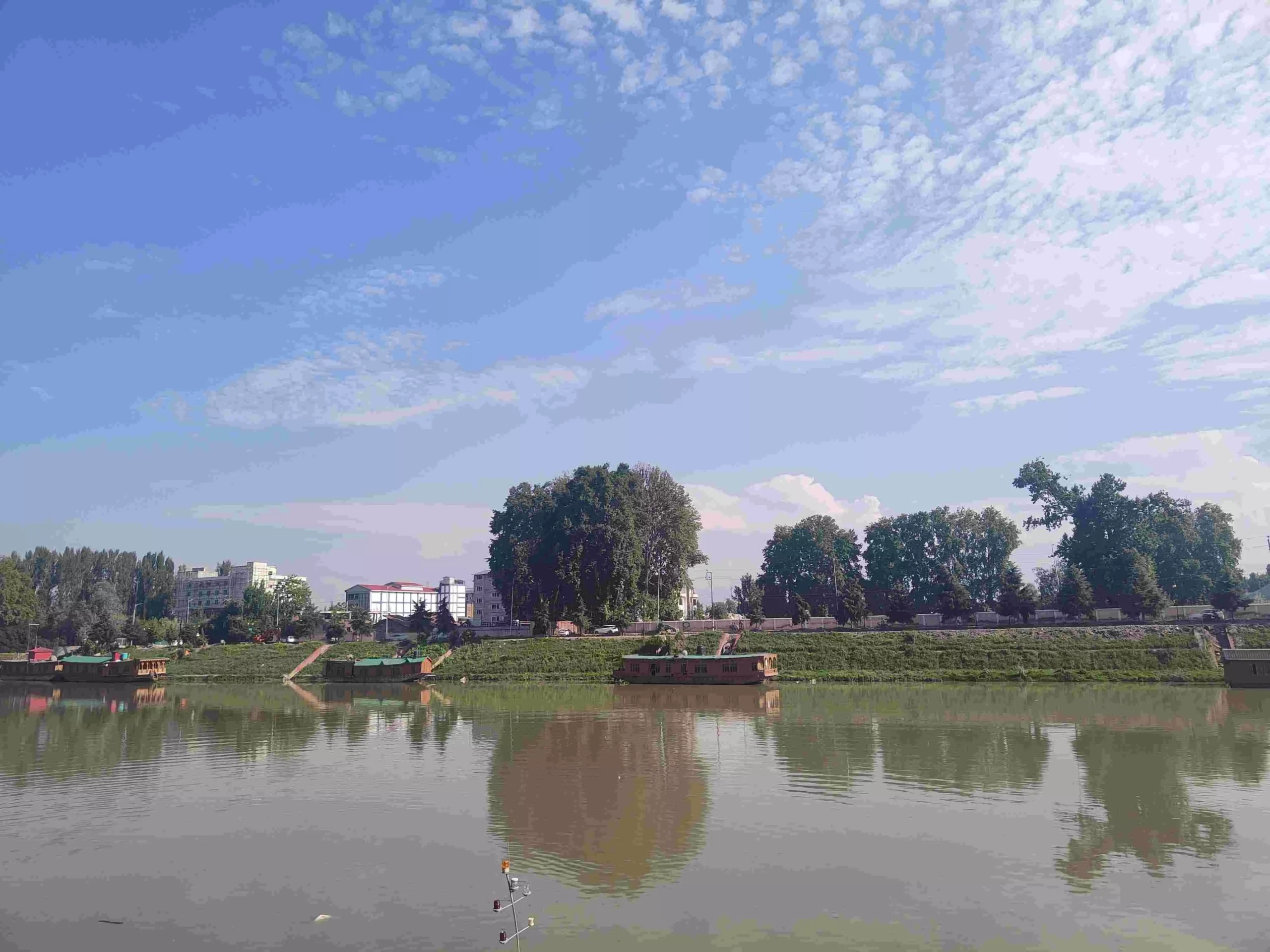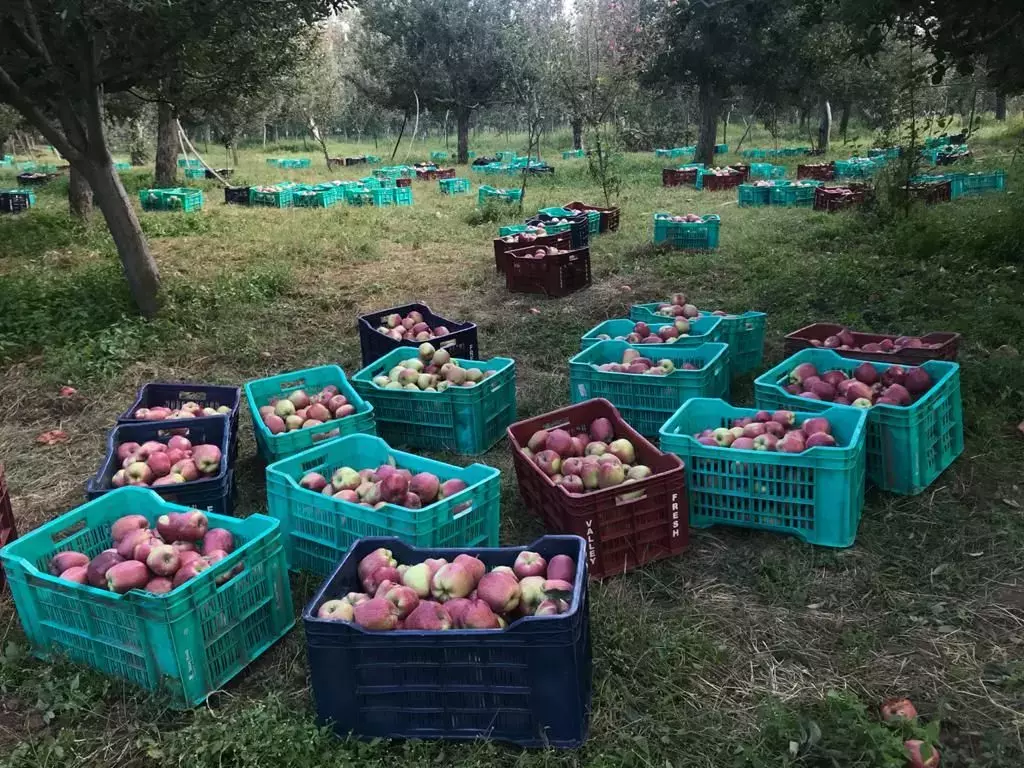Mudassir Kuloo and Hirra Azmat
Srinagar, Jammu & Kashmir
In the second week of March this year, Bashir Ahmad Bhat’s apple orchard was blooming with flowers. He was delighted as this foretold a bumper crop. Little did the farmer from Baramulla district in North Kashmir know then that within the following two weeks more than half the flowers would drop off and many of his trees would wither.
“The unprecedented dry spell withered half the flowers in my orchard. While an early rise in temperature would have benefited farmers, we also needed some rain,” Bhat told Gaon Connection. Bhat owns around a hectare of land, which should have yielded him apples worth Rs 5 lakh. “But we earned less than three lakh rupees this year because the apple trees were damaged due to less rainfall,” he added.
Bhat’s is not an isolated case. There are thousands of farmers in Kashmir facing losses due to the drought-like situations that have prevailed in the valley since March and continued till June.
Horticulture is the mainstay of Kashmir’s economy and it contributes over eight per cent to the Gross Domestic Product (GDP) of the union territory. According to figures of the Horticulture Department Kashmir, about 700,000 families are directly or indirectly associated with the sector. More than 338,000 hectares of land is under fruit cultivation in the valley. Of which 162,000 hectares is under apple cultivation. With poor irrigation facilities, the farmers are dependent heavily on precipitation to water their trees.

A farmer checking dried flowers in his orchard in central Kashmir. Pic: Mudassir Kuloo
Also Read: Heatwaves hit menthol crop; oil production drops by almost 40%
“The reduced precipitation in March and April has largely impacted our crop,” Mehraj Ahmad, a 55-year-old farmer from Central Kashmir’s Ganderbal district, told Gaon Connection. “The early rise in temperature in March led to early sprouting of fruits. Then in April, there was a sudden dip in temperature. We could not irrigate the orchard which led to the drying of trees. The erratic weather conditions have largely hit crop production this year,” he added.
Ahmad said he has lost more than 40 per apple crop in his one and a half hectares of orchard due to the dry spell and influx of pests this year. “I sold apples for four lakh rupees this year. Had there been adequate rains, I would have earned at least seven lakh rupees,” the farmer said.
And to make matters worse, after drought-like conditions, there were flash floods last month in the union territory. The administration has declared “untimely” snow/heavy rain causing flash floods from June 19 to June 22 in Jammu & Kashmir as State Specific Natural Disaster under the State Disaster Response Fund norms.

Snowfall on upper reaches of Kashmir melted early this year due to early rise in temperature: Pic: Irfan Rashid
Deficient rainfall affects crops
Director Meteorological Department, J&K, Sonam Lotus told Gaon Connection that the valley had received less precipitation this year against the average normal rainfall.
“The deficiency of rainfall hit the agriculture and horticulture sectors. Besides, we also witnessed early melting of glaciers this year due to early rise in temperature. It also led to water shortage in many areas. All this is linked to global warming,” Lotus said.
According to him, between March 1 and April 21 this year, Kashmir received only 43 millimetre (mm) rainfall against an average normal precipitation of 209 mm, indicating a deficiency of around 80 per cent, which led to the drought-like situation. “The rains in this period are crucial for the apple and other crops of the region,” he added.
J&K received only 345 mm rainfall in the first five months of 2022 where it should have received an average normal rainfall of 559 mm. This indicates a deficiency of around 40 per cent, the director of the meteorological department pointed out.
Keeping in mind the weather conditions, in the second week of April, the horticulture department issued an advisory advising farmers to immediately irrigate their orchards.
“But irrigation facilities like tube wells are available to only a limited number of farmers,” apple farmer Ahmad from Ganderbal pointed out. He said he was contemplating giving up farming as he has been incurring repeated losses due to the erratic weather and lack of rainfall.

Jehlum has witnessed considerable drop in water levels due to less precipitation this year: Pic: Mudassir Kuloo
According to Akhtar H Malik, junior scientist at Department of Botany, University of Kashmir, “There was early flowering this year but the low precipitation led to them withering. Fruit production is directly dependent on flowering formation, and this impacted production,” he told Gaon Connection.
Abdul Rauf Malik, assistant professor, department of fruit sciences, Sher-e-Kashmir University of Agricultural Sciences and Technology, Kashmir (SKUAST-K) seconded Malik and said: “Early flowering of the apple orchards was directly related to prevailing temperatures.”
In May this year, Kashmir Irrigation and Flood Control Department issued an advisory asking farmers in North Kashmir to avoid sowing paddy owing to dry spell.
For instance, Mohammad Amin, a resident of Pulwama, decided to sow pulses and maize instead of his usual paddy. “Rice requires a good amount of water, so that we could avoid big losses,” he told Gaon Connection.
A sizable portion of paddy crops were affected this year due to dry weather conditions, said Mohammad Iqbal Chowdhary, director agriculture, Kashmir. “We will know the exact losses when crops are harvested. We did issue a number of advisories this year which saved many farmers from losses,” he told Gaon Connection.
Changing weather pattern
In March this year, Srinagar, the summer capital of Jammu and Kashmir recorded a maximum temperature of 20.7 degree Celsius, which was the warmest since 2004. While, the minimum temperature that month stood at 6.7 degree Celsius, which was the highest ever in 131 years. Experts attribute the untimely weather conditions to global warming.
April 2022 saw heat-wave like conditions and the water levels in the Jhelum river and nallahs dropped considerably. While this happened, there was also an early melting of glaciers resulting in many parts of Kashmir facing severe water shortage.
On June 21, Srinagar registered the coldest June day in the last 48 years. According to the official data, the temperature remained 14.2 degree C below normal.
“The changing weather dynamics will greatly impact the agriculture and horticulture sector. From long dry spells to excessive rainfall, 2022 has so far been a year of extremes. It clearly points to the impact of climate change,” Irfan Rashid, senior assistant professor, department of geoinformatics, University of Kashmir, told Gaon Connection.
“The continued decline in glaciers in the years to come can impact the overall Indian Himalayan region. It can lead to the decrease in agricultural productivity, decline in hydropower generation, fall in winter tourism and drinking water scarcity,” the expert added.

More than 338,000 hectares of land is under fruit cultivation in the valley. Of which 162,000 hectares are under apple cultivation. Pic: By arrangement
Also Read: Mango production in India to be hit due to early arrival of heatwaves
Many hill states of the country are under stress due to climate change, Malik, assistant professor with SKUAST-K, said. “Changes in the time of blooming and harvest are already being seen. Inadequate winter chilling, less rain, scab formation and pest attacks were all indicators of climate change,” he pointed out.
Kashmir has witnessed erratic weather patterns for several years with experts attributing it to global warming.
Drought-conditions aside, the valley also faced flash floods last month due to abrupt rainfall. These flash floods caused considerable damage. “The flash floods hit the nomads as grazing areas were inundated. Whenever there is a sudden increase or decrease in temperature, local biodiversity of that particular area including wildlife gets disturbed,” Malik from SKUAST-K said. “Flash floods due to inclement weather also led to loss of fertile soil. The productivity of grasslands and plant diversity also gets affected,” the scientist pointed out.


















